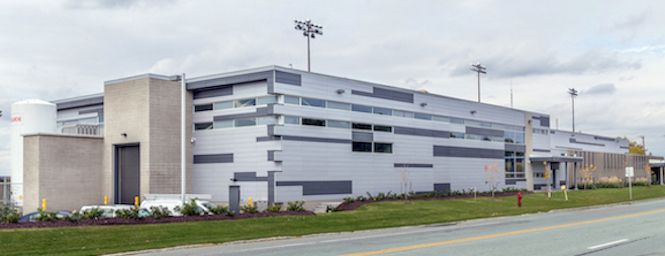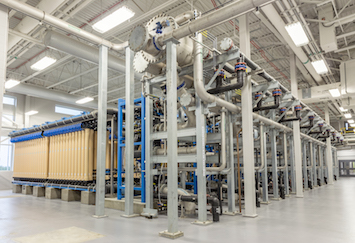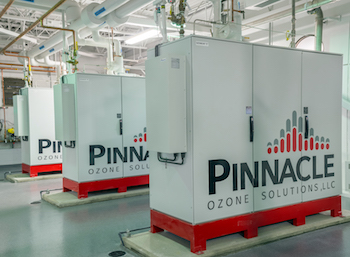
Advanced Drinking Water Treatment
July 10, 2017
By exp Services
The re-making of the J.-M. Jeanson Drinking Water Treatment Plant in Sherbrooke achieves economic and environmental goals.

Exterior of the addition to the J.-M. Jeanson drinking water treatment plant in Sherbrooke.
The introduction of innovative technologies have led to a drinking water solution for the City of Sherbrooke, Quebec that exceeds existing provincial regulations, has room for higher capacity and delivers clean water in a more sustainable method than in the past.
The J.-M.-Jeanson drinking water treatment plant in Sherbrooke required updating to meet provincial quality standards and it needed to be able to service a growing population.
The engineering design team was challenged with upgrading an existing, relatively small, facility to maintain costs, while also managing the construction process without disrupting service to the existing population of over 150,000 residents.
A three-link chain
A feasibility-study, laboratory-analysis and pilot-test reports and results led to the development of a treatment chain for an enlarged and restored new-generation plant. The plant would be treating lake-drawn water using pressure-driven membrane microfiltration, with a 0.1-micron porosity, followed by very-high-frequency ozonation and chlorination, while ultimately emitting a very small quantity of wastewater.
The upgraded Sherbrooke plant, commissioned in February 2015, is now one of a few plants in North America equipped with a secondary membrane filtration system, and when installed was operating the world’s largest very-high-frequency ozonation system.
As a result of its upgrade, the J.-M.-Jeanson plant can now supply residents with a flow of approximately 100,000 m3/day.

The primary membrane filtration room and the membrane train.
Microfiltration solution
Completed at an under-budget cost of $31.4M, the modern plant includes the largest drinking water membrane filtration system in Quebec. To minimize the footprint because of the small space available on the site, the design of the system with its different components was implemented over two floors, with only 1,165 m2 added to the 1,350 m2 of the rehabilitated existing facility.
Laboratory testing conducted on source water drawn from Memphrémagog Lake showed that processing the lake’s lightly-loaded water using conventional treatment methods failed to produce flocs large and dense enough to settle and be removed.
On-site pilot tests conducted using hollow fibre microfiltration membranes led to the selection of pressure-driven microfiltration technology from New York-based Pall Industries. The primary membrane filtration system transforms raw water without coagulant agent added into drinking water using nine membrane trains, including one for redundancy.
The dirty waters from the backwash of the primary membranes are also treated. This dirty water is collected and treated by the unique secondary membrane filtration system, independent from the primary system.
It’s this water that is reused to backwash the primary system. In conventional processes, drinking water produced by the plant is used for backwashing. The use of the secondary membrane filtration system is an advanced sustainability process that reduces the waste of fully-treated drinking water and providing savings over the long run.
Part of the design team challenge was also minimizing discharge to the sewer to avoid having to expand the local wastewater treatment facility.
 Ozonation
Ozonation
The very-high-frequency ozone generation technology, from Pinnacle Ozone Solutions out of Florida, is a compact system that allows for easy maintenance, and it doesn’t require the addition of nitrogen to generate ozone from pure liquid oxygen.
This ozone generating process also differs from low-frequency or medium-frequency ozone generators in many ways including: requiring less space; providing better ozone production rates while reducing stress on the dielectrics; the absence of stainless steel tanks is a long-term advantage as a recurring problem associated with low- and medium-frequency systems comes from the degradation of tank welds by nitric acid formed during the production of ozone.
As the second link in the treatment chain, the ozonation process further increases the water clarity, helps cut down trihalomethanes (carcinogenic compounds), tastes and odours in the water, and provides an efficient treatment of cyanobacteria (blue-green algae) and related cyanotoxins, while also contributing slightly to the disinfection.
Cleaner chlorination
The final step in the process, chlorination, is the only chemical treatment used at the facility. And the plant was able to replace gaseous chlorine (highly toxic) with liquid chlorine, providing an improvement to the overall safety. The facility is located next to the main campus of the Université de Sherbrooke, so safety concerns extend beyond the facility itself to its close neighbours.

Five 200hp primary supply pumps and pre-sieving in the basement.
Efficiency
In all, the complete system is a highly-automated process, including 1,200 alarm points in membrane filtration alone, where control and operations are possible using tablet computers near the equipment, and they provide complete and ongoing monitoring of the process.
The system is also optimized for energy efficiency, using variable-frequency drive starters and the very high-frequency ozonation. The equipment is capable of meeting demand, without exceeding it.
Other sustainability features include: heat recovered from engines is used to heat the facility; the plant’s white roof contributes to reducing the heat island effect; a retention basin with a flow regulator is used to manage runoff from facility roof and parking lots; and exterior lighting was designed in accordance with Mont-Mégantic International Dark Sky Reserve guidelines and with a commitment to fight light pollution.
Minimal waste
One of the facility’s prime accomplishments is the very small quantity of wastewater that is generated in the overall water treatment process. There is a marginal 0.4% discharge to sewer (compared to typical values ranging from 5-10%). The waste, which is transferred to the wastewater treatment facility in the form of concentrated sludge, eliminated excess strain on the local wastewater treatment facility, which was one of the design team’s objectives.
The City of Sherbrooke is now distributing drinking water of a quality that surpasses current Quebec regulatory standards, with an average turbidity of only 0.011 NTU, a value that is almost 10 times below the 0.1 NTU maximum.
Considering that its performance exceeds current regulatory requirements, the plant will continue to meet regulatory requirements as standards increase.